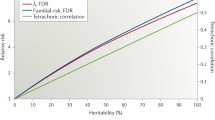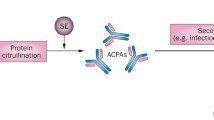Abstract
Aims: To compare methodological aspects of the impact of different classification procedures used in three phases of a twin study examining genetic factors in the aetiopathogenesis of rheumatoid arthritis (RA).
Methods: We have previously reported the results of a study of the aetiopathogenesis of RA based on the Australian Twin Registry (ATR). In the original 258 pairs self-reporting a diagnosis of RA in twin, co-twin or both, a very high false positive self-reporting rate for RA was noted (Phase 1). Subsequent diagnostic information obtained by a disease-specific questionnaire, followed by telephone interviews with subjects and review of information obtained by mail and telephone interview from the patient’s general practitioner or musculoskeletal specialist, identified 23 ‘true’ RA pairs (Phase 2). Pairwise concordance percentages for RA based on those 20 discordant and 3 concordant pairs were as follows: monozygotic (MZ) 21% (95% confidence interval (CI)=6–44%), dizygotic (DZ) 0% (95% CI=0–25%) (probandwise concordance MZ 35% (8.9–67.3), DZ 0% (0–50.3)). Given the potential effects of misclassification on data interpretation, we have further pursued the accuracy of diagnosis by a systematic clinical, serological and radiographical evaluation of the 23 RA pairs (Phase 3).
Results: In only one instance did more intense diagnostic investigation of the 23 pairs result in recategorization. The probandwise concordance percentages were recalculated: MZ=37.5%, DZ=0%.
Conclusions: Our original contention that genetic factors play some part in the aetiopathogenesis of RA, but do not account entirely for its determination, has been substantiated at a higher level of confidence and at almost identical levels of concordance.
Similar content being viewed by others
References
Claussen F, Steiner F. Die Bedentung der Konstitution fur die Erkrankung an Gelenkrheumatismus. Verk Dtsck Ges Inn Med. 1938;50:299–303.
Edstrom G. Klinische Studien uber den chronischen Glenkrheumatismus. I. Das Erbbid. Acta Med Scand. 1941;108:398–413.
Brandt G, Weibe TA. Polyarthritis rheumatica bei zwillingen. Z Menschel Vereb-u Komizit Lekre. 1939;23:169–88.
Thymann G. Polyarthritis in twins. Acta Genet Basel. 1957;7:148–50.
Moesmann G. Factors precipitating and predisposing to rheumatoid arthritis as illustrated by studies in monozygotic twins. Acta Rheumatol Scand. 1959;5:291–303.
Harvald B, Hauge M. Hereditary factors elucidated by twin studies. In: Genetics and the Epidemiology of Chronic Diseases. Washington, DC., US Public Health Service; 1965:61.
Meyerowitz S, Jacox RF, Hess DW. Monozygotic twins discordant for rheumatoid arthritis: a genetic, clinical and psychological study of 8 sets. Arthritis Rheum. 1968;1:1–21.
Tarp U, Gaudal HK. Seropositive rheumatoid arthritis in monozygotic twin sisters carrying HLA-DR4 or DR4 associated with B27. J Rheumatol. 1989;16:1530–2.
Lawrence JSH. Rheumatoid arthritis — nature or nuture? (Heberden Oration, 1969). Ann Rheum Dis. 1970;29:357–79.
Aho K, Koskenvuo M, Tuominen J, Kaprio J. Occurrence of rheumatoid arthritis in a nationwide series of twins. J Rheumatol. 1986;13:899–902.
Bellamy N, Duffy D, Martin N, Mathews J. Rheumatoid arthritis in twins: a study of aetiopathogenesis based on the Australian Twin Registry. Ann Rheum Dis. 1992;51:588–93.
Silman AJ, MacGregor AJ, Thomson W et al. Twin concordance rates for rheumatoid arthritis: results from a nationwide study. Br J Rheumatol. 1993;32:903–7.
Arnett FC, Edworthy SM, Bloch DA et al. The American Rheumatism Association 1987 revised criteria for the classification of rheumatoid arthritis. Arthritis Rheum. 1988;31:315–24.
Kimura A, Sasazuki T. Eleventh International Histocompatability Workshop Reference Protocol for the HLA DNA-typing Technique. In: Tsuji K, Aizawa M, Sasazuki T, eds. HLA 1991. Oxford: Oxford University Press; 1992;1:397–419.
Olerup O, Zetterquist H. HLA-DR typing by PCR amplification with sequence specific primers (PCR-SSP) in 2 hours: An alternative to serological DR typing in clinical practice including donor-recipient matching in cadaveric transplantation. Tissue Antigens. 1992;39:225–35.
Ota M, Seki T, Fukushima H et al. HLA-DRB1 genotyping by modified PCR-RFLP method combined with group specific primers. Tissue Antigens. 1992;39:187–202.
Author information
Authors and Affiliations
Rights and permissions
About this article
Cite this article
Bellamy, N., Duffy, D.L., Sambrook, P. et al. A methodological appraisal of the impact of different classification procedures used in three different phases of the australian rheumatoid arthritis twin survey. Inflammopharmacol 6, 81–89 (1998). https://doi.org/10.1007/s10787-998-0009-1
Received:
Accepted:
Issue Date:
DOI: https://doi.org/10.1007/s10787-998-0009-1




